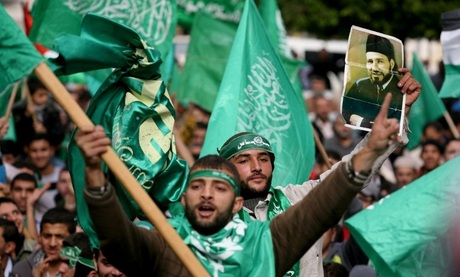Hamas, the Government in Gaza
إقرأ هذا الخبر بالعربية
Following are key dates in the evolution of Islamist Palestinian movement Hamas, a sworn enemy of Israel that seized power in Gaza 10 years ago.
- Founding 'Charter' -
Hamas is created on December 14, 1987 after the first Palestinian uprising known as the intifada began. Hamas is founded by a group of militants close to the Muslim Brotherhood organization, one of whom is Sheikh Ahmed Yassin.
Hamas is an Arabic acronym for Islamic Resistance Movement, and it was formed as a rival to the militant group Islamic Jihad.
On August 18, 1988, Hamas adopts a "charter" to match one by another rival, the Palestine Liberation Organization (PLO), and which calls for an Islamic state throughout Palestine that includes Israel.
The group builds up a strong network of social aid programs that focuses in particular on social welfare schools.
- First suicide attack -
In 1990, Hamas creates an armed wing called the Ezzedine al-Qassam Brigades after an Arab nationalist who fought British mandate rule of Palestine before Israel was created.
On September 14, 1993, a day after the Oslo peace accord was signed by Israel and the PLO, hundreds of Hamas militants protest and call for continued attacks against the Israeli army.
The demonstrations coincide with the first Hamas suicide attack in Gaza. Only the attacker dies in the blast.
Fighters from the Ezzedine al-Qassam Brigades subsequently commit many attacks on Israeli soldiers and civilians, and also kill Palestinians suspected of collaboration with Israel.
- 'Targeted' assassinations -
Sheikh Ahmed Yassin, the spiritual leader of Hamas, is killed by an Israeli helicopter as he leaves a Gaza mosque on March 22, 2004.
Yassin's successor, Abdel Aziz Rantissi, dies less than a month later, also during an Israeli raid.
Since then, other "targeted" assassinations have claimed the lives of many Hamas political and military leaders. They include Yahya Ayyash, whose mobile telephone exploded in 1996, and Salah Shehade, founder of the Ezzedine Al-Qassam Brigades, in 2002.
- Hamas takes over Gaza -
On September 12, 2005 after dismantling the last Israeli settlement in Gaza, Israeli forces withdraw from the territory, ending 38 years of occupation.
On January 25, 2006, Hamas wins a landslide electoral victory over Palestinian President Mahmoud Abbas' Fatah movement, and on June 15, 2007 Hamas takes control of Gaza following fierce fighting with Fatah supporters. Israel tightens a blockade of Gaza.
- Israeli response -
On July 8, 2014, Israel launches Operation Protective Edge, to halt rocket attacks from Gaza and destroys tunnels used to reinforce and resupply Hamas fighters there.
The fighting is the third major military operation since 2007 and results in the death of 2,251 people on the Palestinian side, including 551 children, according to U.N. figures.
Israeli casualties are put at 74, of which 68 are soldiers.
- Hamas adopts 'political' fight -
On February 13, 2017, Hamas military leader Yahya Sinwar is elected head of Gaza.
On May 1, Hamas announces changes to its founding charter that refer to a "political" fight with Israel as opposed to a "religious" conflict. Hamas speaks of a future Palestinian state that includes just the occupied West Bank, East Jerusalem, and Gaza.
For the Israeli government, Hamas is just "attempting to fool the world."
A few days later, ex-Gaza chief Ismail Haniya is elected as the new Hamas leader. Sinwar is a hardliner, while Haniya is considered more moderate within the movement.
"On July 8, 2014, Israel launches Operation Protective Edge, to halt rocket attacks from Gaza"
Or in plain simple English, if Hamas had not provoked Israel by rocket attacks then there would have been no reason for the Israeli retaliation.
Hamas brought this on themselves.



